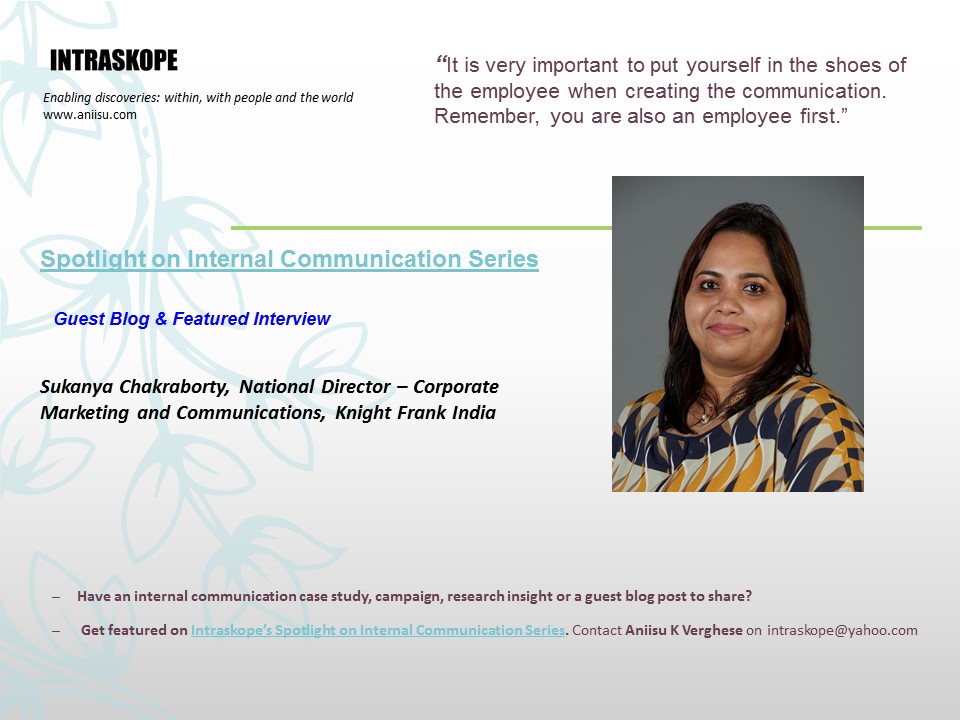Can internal communicators be the foil between the management and employees? How can internal communicators get the pulse of their employees? What can influence employee trust?
Read this and more in the 11th edition of Intraskope’s Spotlight on Internal Communication Series as Sukanya Chakraborty, National Director – Corporate Marketing and Communications, Knight Frank India shares a blog on shared ownership with internal communication and follows it up with an interview where she articulates what it takes for internal communicators to stand up and be counted.
Sukanya is a multi-disciplinary B2B and B2C marketer with 18+ years of experience in corporate marketing and communications with global IT & consulting services, property consulting, interactive media and community start-up companies. She has proven experience in thought leadership, positioning, media relations, influencer relations, digital media, employee communications and CSR among other domains.
Blog: Internal Communications, whose responsibility is it?
As companies grow, the need to connect the employees gets stronger than ever. Today, every company irrespective of size has recognised the need for internal communications. The definition, tactics, strategy and maturity though may vary.
However, the debate on ownership remains. Many believe that HR should be responsible; after all they are a key touch-point for employees. Many say Corporate Communications should drive it because they understand culture, brand and positioning objectives much better than anyone else.
I believe that internal communications is not the prerogative of one department; rather it has to be a company-wide effort.
Internal communications is essentially engaging employees by making them part of the company, culture and its success. And the best way would be involvement of leadership. Top leaders can initiate conversations, provide updates, or invite employees for a dialogue. Being heard and being able to contribute will go a long way to make an employee engaged, a shift from just being happy.
Team managers often miss their part in making internal communications successful. Along with the top management, managers also have a key role to make internal communications a part of the organisation culture. Before employees voice their opinions, share thoughts and ideas with the top management, they should feel confident to be open with their immediate managers. The other key role of internal communications is to foster collaboration between departments. Managers need to encourage this and get people together rather than working in silos. Apart from this, managers should also motivate their teams to participate in the various employee engagement initiatives undertaken by Corporate Communications or HR teams. These channels and initiatives are designed to help provide employees with platforms to collaborate with their peers and express their views both of which are key ingredients towards making a brand an ‘employer of choice’ and the employees as responsible ‘brand ambassadors’.
Different teams within a company are responsible for different aspects of internal communication. While HR plays a key role in this matrix of internal communications with focus on employee engagement and retention strategies; corporate communications works on the channels to disseminate the right messaging, making the process inclusive. Additionally, with proper guidelines in place, messaging can be monitored for maximum impact and positive communication habits set paving way towards building a culture of communication.
Therefore, for internal communications to truly succeed in its spirit, it must be addressed across all levels. While the top management can help establish the framework along with HR and Corporate Communications, managers have to take it to the next step. It is after all a team sport!
Q&A:
- What does internal communication mean to you?
Internal Communications to me is communication that is made relevant to each and every employee thereby increasing employee engagement and making employees feel connected with the company.
In today’s day and age, employees are the best brand ambassadors a company or brand has. With social media dominating every waking hour of our lives, it is imperative that all employees speak the same language when it comes to representing the organisation in a public forum. This is where Internal Communications plays a key role in ensuring that the company vision and values are cascaded across all hierarchies and everyone knows their role in keeping the wheels well-oiled.
- How is it practiced in your organization?
At Knight Frank, depending on the campaigns, we apply a mix of proactive and reactive tactics. We use mailers, Intranet, posters, wallpapers / lockscreens etc as channels to disseminate information during campaigns. While there is a structure in place, we need to move to the next steps of measuring the effectiveness of the same.
- Please share an example/campaign that you are personally proud of working on and that made a significant impact to your organization.
Revival of the monthly internal newsletter is something that I would like to pick as an example. Every month, our global management team looks forward to reading the updates from India.
We have seen lot more participation from employees over the years in providing content. Also the editorial committee has employee representation from each region and vertical, thereby making it more inclusive and participatory rather than being driven from the HQ. In our case, a monthly newsletter has always worked, though there were concerns on the content continuity every month. However, that challenge was overcome by devising new campaign ideas that can work across channels. Appreciation mails from those reading it really works wonders for our morale to keep continuing the newsletter. Except surveys, we do not have a formal channel to measure the effectiveness.
- What is the biggest challenge you face while going about managing internal communication?
As I said earlier, measuring the effectiveness of internal campaigns is important to gauge how it has been received or understood by the target audience. We would need tools and metrics to put in place a measurement mechanism.
- What according to you is the biggest opportunity that internal communicators have?
According to me the biggest opportunity that internal communicators have is to be an interface between the voice of the employee and the company. As internal communicators we have the dual responsibility of cascading leadership messages while ensuring that employees are engaged to the brand. Once employees are on-boarded, it becomes imperative for communicators to continue to keep the brand relevant as an ‘employer of choice’.
- How can internal communicators add more value to the business?
Internal communicators need to work towards increasing employee engagement, which could lead to employees feeling more connected with the company and its vision thereby going beyond their call of duty towards making the company successful.
- What is your advice for people who are keen to join internal communication and make a career? What skills must they have or develop?
Internal communications is a very people centric role. As an internal communicator you will be interacting with people across hierarchies from the board room to the shop floor. Hence you must understand that whatever you communicate has to be relevant to employees across levels. It is all about the relevance of the message.
While the basics of written and verbal communication remain vital, it is very important to put yourself in the shoes of the employee when creating the communication. Remember, you are also an employee first.
Missed previous stories from organizations featured on the Intraskope’s Spotlight on Internal Communication Series? Look them up here – Infosys, SOBHA Ltd., ICICI Securities, First Advantage, CK Birla Group, TVS Motors, GE, Suzlon, Tata Sons and Percept.
If you are an internal communication practitioner working in a firm or a not-for-profit and have an internal communication case study, campaign, research insight or a guest blog post to share please contact me on [email protected]
You can also now subscribe to my YouTube Channel for more updates.




Insightful article and very informative for internal communication professionals and for those aspiring to be come one! Thanks for this!